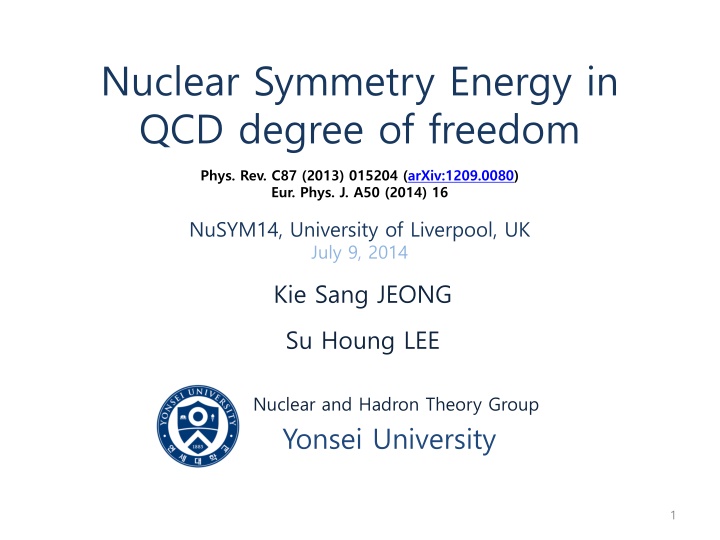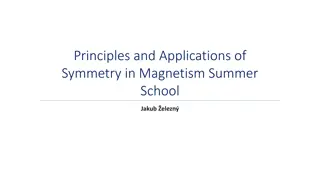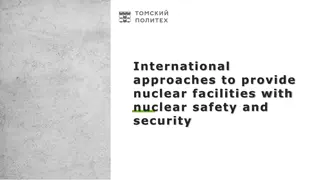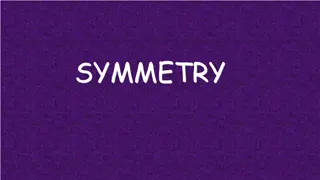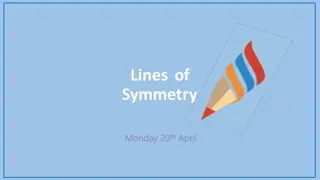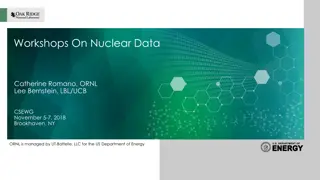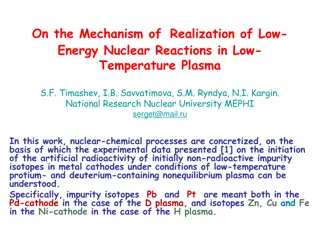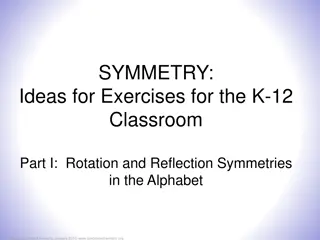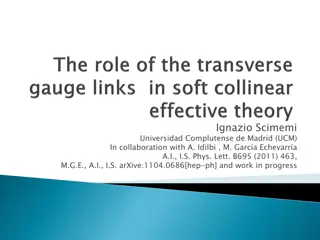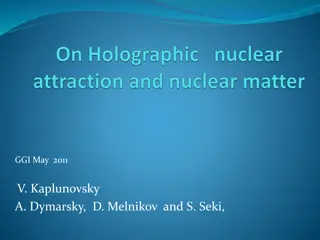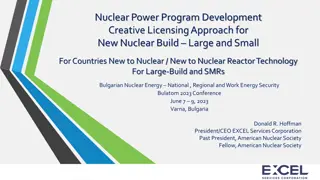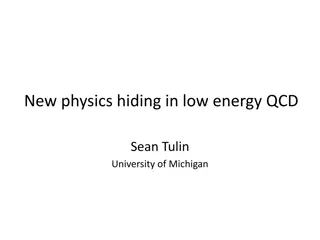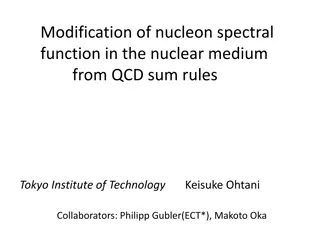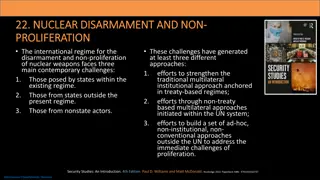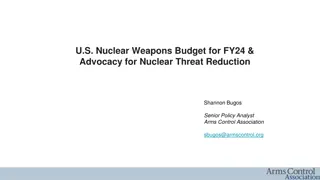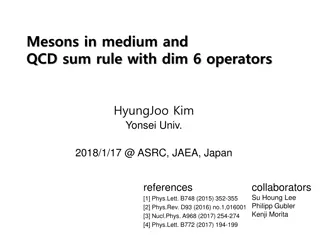Nuclear Symmetry Energy in QCD Degree of Freedom
Understanding the nuclear symmetry energy in the context of Quantum Chromodynamics (QCD) is essential for nuclear phenomenology. This study explores topics such as QCD sum rules, mean field approximation, and operator product expansion to decipher the energy properties of nuclear systems. The research delves into the comparison of meson exchanges, vector and scalar decompositions, and the impact of twist-4 operators on the symmetry energy. Additionally, it examines the implications of extremely high density scenarios and QCD phase transitions on nuclear dynamics.
Download Presentation

Please find below an Image/Link to download the presentation.
The content on the website is provided AS IS for your information and personal use only. It may not be sold, licensed, or shared on other websites without obtaining consent from the author.If you encounter any issues during the download, it is possible that the publisher has removed the file from their server.
You are allowed to download the files provided on this website for personal or commercial use, subject to the condition that they are used lawfully. All files are the property of their respective owners.
The content on the website is provided AS IS for your information and personal use only. It may not be sold, licensed, or shared on other websites without obtaining consent from the author.
E N D
Presentation Transcript
Nuclear Symmetry Energy in QCD degree of freedom Phys. Rev. C87 (2013) 015204 (arXiv:1209.0080) Eur. Phys. J. A50 (2014) 16 NuSYM14, University of Liverpool, UK July 9, 2014 Kie Sang JEONG Su Houng LEE Nuclear and Hadron Theory Group Yonsei University 1
Motivation and Outline Nuclear phenomenology QCD sum rule Re V>0 Re S<0 Dirac optical potential Extremely high density matter? QCD itself is main dynamics Physical Review C49, 464 (1993) (Thomas Cohen et al.) (V. Baran et al.) Physics Report, 410, 335 (2005) Cold matter Symmetry Energy from Hard Dense Loop resummation Color BCS pairing Rev. Mod. Phys. 80, 1455 (2008) (M. G. Alford et al.) 2
Mean field approximation Quasi-nucleon on the asymmetric Fermi sea Nuclear Symmetry Energy in continuous matter (Up to linear density order) RMF type nucleon propagator 3
QCD Sum Rule Correlation function Ioffe s interpolating field for proton Energy dispersion relation Contains all possible hadronic resonance states in QCD degree of freedom Phenomenological ansatz in hadronic degree of freedom Equating both sides, hadronic quantum number can be expressed in QCD degree of freedom Weighting - Borel transformation 4
QCD Sum Rule Operator Product Expansion Non-perturbative contribution In-medium condensate near normal nuclear density Medium property can be accounted by nucleon expectation value x density Multi-quark operators (twist-4) can be estimated from DIS experiments data 5
Nuclear Symmetry Energy fom QCD SR Iso-vector scalar / vector decomposition of Nuclear Symmetry Energy RMFT result Iso-vector meson exchange Vector meson exchange -> Repulsive Scalar meson exchange -> Attractive (Physics Report 410, 335, V. Baran et al.) Twist-4 excluded Esym(GeV) In the result without twist-4 ops., both self energies give weak contribution Twist-4 included Contribution of Twist-4 Ops. enhances Scalar attraction Vector repulsion mechanism quark operator Becomes important at high density? -> Have to find counter multi 6
At extremely high density? QCD phase transition In region, QCD can be immediately applicable Statistical partition function for dense QCD Normal QM phase - BCS paired phase Euclidean Lagrangian for dense QCD at normal phase (For fermion) (For boson) Continuous energy integration -> Discrete sum over Matsubara frequency 7
Hard Dense Loop resumation Gluon self energy in cold matter (Q~T g ) ~ order -> all equivalent 1PI diagrams should be resumed! Phys. Rev. D.53.5866 (1996) C. Manuel Phys. Rev. D.48.1390 (1993) J. P. Blaizot and J. Y. Ollitrault Only quark-hole excitation is relevant (Q~T g ) Effective Lagrangian for soft gluons Gluon/Ghost contribution (~T g ) is negligible Debye mass from hard(dense) quark loop 8
HDL resumed thermodynamic potential Relevant ring diagrams Where in T g limit Thermodynamic quantities can be obtained from Preliminary Ideal quark gas HDL involved 9
Symmetry Energy at normal phase Symmetry Energy Preliminary Ideal quark gas HDL involved HDL correction suppress Quasi-Fermi sea As density becomes higher, suppression becomes stronger The difference between quasi- Fermi seas becomes smaller => Reduced symmetry energy 10
Color Superconductivity BCS Pairing near Fermi sea In terms of effective interaction near Fermi sea is marginal along to Fermi velocity Fermion conjugated fermion interaction When V<0 two states form a condensate (gap) Nambu-Gorkov Formalism Inverse propagator of Diagrammatical described gapped quasi-state -> In Wilsonian high density effective formalism 11
Color BCS paired state BCS Pairing locks the gapped quasi-states In QCD, anti-triplet gluon exchange interaction is attractive (V<0) In non negligible , 2SC state is favored 2 color superconductivity In 2SC phase, u-d red-green states are gapped Ms ~ 150 MeV ~ 400 MeV s quarks d (blue) u-d red green quasi-Fermi sea is locked s quarks u (blue) Only s quarks and u-d blue quarks are liberal 12
Symmetry energy at 2SC phase Only Blue state affects iso-spin asymmetry In Wilsonian effective formalism (HDET) BCS phase remains in (Phys. Rev. Lett. 9, 266 (1962) A. M. Clogston ) Symmetry energy Preliminary BCS gapped (2SC) Ideal quark gas HDL involved Only u-d blue states can be asymmetrized The other 4 gapped quasi-states are locked 13
Future goals and Summary Meissner mass effect Nuclear Symmetry Energy in hadron and quark phase When gap size is quite large Hadron phase | Quark phase Not need resummation -> reduction vanish When gap size is quite small -> need resummation -> reduction remains BCS gapped (2SC) Symmetry Energy from QCD SR (Kin. + Pot.) Ideal quark gas Hadron-quark continuity? HDL involved Kinetic part (Ideal nucleon gas) Kinetic part (QCD SR based interaction involved) Important quantum numbers? (e.g. strangeness) -> High density behavior at hadron phase 14
Conclusion For hadron phase, Nuclear Symmetry Energy can be described in terms of quark and gluon condensate via QCD Sum rule For quark phase (in T~0 limit), Symmetry Energy of normal phase can be calculated immediately via thermal QCD. The Debye mass from HDL resummation reduces Symmetry Energy BCS paired states lock the gapped quasi-states and favors symmetrized condition (enhancing Symmetry Energy) Quark-hadron continuity may provide fruitful information for high density behavior in hadron phase 15
